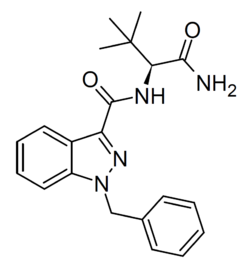Chemistry:ADB-BINACA
From HandWiki
Short description: Chemical compound
 | |
| Legal status | |
|---|---|
| Legal status |
|
| Identifiers | |
| |
| CAS Number | |
| PubChem CID | |
| ChemSpider | |
| UNII | |
| Chemical and physical data | |
| Formula | C21H24N4O2 |
| Molar mass | 364.449 g·mol−1 |
| 3D model (JSmol) | |
| |
| |
ADB-BINACA is a cannabinoid designer drug that has been found as an ingredient in some synthetic cannabis products.[1] It was originally developed by Pfizer as a potential analgesic, and is a potent agonist of the CB1 receptor with a binding affinity (Ki) of 0.33 nM and an EC50 of 14.7 nM.[2]
ADB-BUTINACA
The analogue with a 1-butyl substitution on the indazole ring rather than 1-benzyl has also been sold as a designer drug under the name ADB-BINACA, but is now more commonly referred to as ADB-BUTINACA to avoid confusion with the benzyl compound.[3][4][5][6][7] It is a similarly potent CB1 agonist, with a binding affinity of 0.29nM for CB1 and 0.91nM for CB2, and an EC50 of 6.36 nM for CB1.[8][9][10]
See also
- 4F-ADB
- 5F-AB-PINACA
- 5F-ADB
- 5F-ADB-PINACA
- ADB-CHMINACA
- ADB-FUBICA
- ADB-FUBINACA
- ADB-HEXINACA
- ADB-PINACA
- ADB-4en-PINACA
References
- ↑ "Four types of cannabimimetic indazole and indole derivatives, ADB-BINACA, AB-FUBICA, ADB-FUBICA, and AB-BICA, identified as new psychoactive substances". Forensic Toxicology 34: 133–143. 2016. doi:10.1007/s11419-015-0297-2. PMID 26793280.
- ↑ "Indazole Derivatives" WO patent 2009106982
- ↑ "Detection of ADB-BUTINACA Metabolites in Human Urine, Blood, Kidney and Liver". Journal of Analytical Toxicology 46 (6): 641–650. July 2022. doi:10.1093/jat/bkab088. PMID 34341821.
- ↑ "Urinary Metabolite Biomarkers for the Detection of Synthetic Cannabinoid ADB-BUTINACA Abuse". Clinical Chemistry 67 (11): 1534–1544. November 2021. doi:10.1093/clinchem/hvab134. PMID 34387654.
- ↑ "The metabolism of the synthetic cannabinoids ADB-BUTINACA and ADB-4en-PINACA and their detection in forensic toxicology casework and infused papers seized in prisons". Drug Testing and Analysis 14 (4): 634–652. April 2022. doi:10.1002/dta.3203. PMID 34811926. https://discovery.dundee.ac.uk/en/publications/a9c83a12-49d4-4b09-8f08-83bac57bcc24.
- ↑ "Quantification of MDMB-4en-PINACA and ADB-BUTINACA in human hair by gas chromatography-tandem mass spectrometry". Forensic Toxicology 40 (2): 340–348. July 2022. doi:10.1007/s11419-022-00615-z. PMID 36454410.
- ↑ "Clinical features associated with ADB-BUTINACA exposure in patients attending emergency departments in England". Clinical Toxicology 60 (10): 1094–1098. October 2022. doi:10.1080/15563650.2022.2101469. PMID 35943421.
- ↑ https://cdn.who.int/media/docs/default-source/controlled-substances/45th-ecdd/adb-butinaca_draft.pdf
- ↑ "Synthesis and in Vitro Cannabinoid Receptor 1 Activity of Recently Detected Synthetic Cannabinoids 4F-MDMB-BICA, 5F-MPP-PICA, MMB-4en-PICA, CUMYL-CBMICA, ADB-BINACA, APP-BINACA, 4F-MDMB-BINACA, MDMB-4en-PINACA, A-CHMINACA, 5F-AB-P7AICA, 5F-MDMB-P7AICA, and 5F-AP7AICA". ACS Chemical Neuroscience 11 (24): 4434–4446. December 2020. doi:10.1021/acschemneuro.0c00644. PMID 33253529.
- ↑ "Systematic evaluation of a panel of 30 synthetic cannabinoid receptor agonists structurally related to MMB-4en-PICA, MDMB-4en-PINACA, ADB-4en-PINACA, and MMB-4CN-BUTINACA using a combination of binding and different CB1 receptor activation assays: Part I-Synthesis, analytical characterization, and binding affinity for human CB1 receptors". Drug Testing and Analysis 13 (7): 1383–1401. July 2021. doi:10.1002/dta.3037. PMID 33787091.
 |

